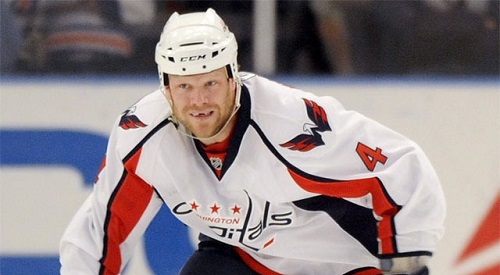
NHL officiating and the long road to a cleaner game
When Brendan Shanahan replaced Colin Campbell as the NHL’s head disciplinarian in the summer of 2011, many assumed the league’s inconsistent officiating and punishments for illegal behavior would cease. But the general feeling at the end of the season was there was room for improvement.
It’s long been known the NHL is behind in regards to cracking down on cheap shots and hits to the head, but in some calls this season we could be seeing the first strides in protecting the players and trying to curb unnecessary injuries.
Washington Capitals defenseman John Erskine was suspended three games for his elbow to the head of Philadelphia Flyers right wing Wayne Simmonds. Last season Buffalo Sabres left wing Ville Leino received only one game for the exact same play to Philadelphia’s Matt Read. Though Read wasn’t injured on the play and Simmonds was, this is still a heavier crackdown on a flying elbow to the head that has been responsible for many concussions in the past.
We know suspensions work. Matt Cooke went from being the dirtiest players in the NHL to recording just 44 PIM last season after a 17-game suspension for repeatedly targeting players’ heads. But suspensions are easy to call with plenty of time and numerous camera angles to view an infraction. Calling a play in real time on the ice is trickier and although there have been some suspect calls on the ice at least it shows the league now has safety in mind.
Perhaps the most notable call this season is the match penalty handed to St. Louis Blues captain David Backes for his hit in Red Wings defenseman Kent Huskins which was later rescinded by the league. Backes’ check was a solid shoulder to the chest of Huskins, but the whiplash triggered by the hit caused the referee to feel there was a blow to the head and Backes was out of the game. Though it was a terrible call, it gave the Red Wings a five-minute power play they used to score the game-winning goal, the intent was to protect other players by announcing hits to the head will not be tolerated and will be punished.
[php snippet=1]
To a lesser extent, Philadelphia’s Zac Rinaldo was called for boarding Washington Capitals defenseman John Carlson that same night on a shoulder-to-shoulder check behind the net on what was likely more of a reputation call than anything else.
Then there are the goalie interference calls, including one on Sam Gagner in the Edmonton-Los Angeles game that called back a goal moments before Nail Yakupov’s infamous celebration and one on Sunday that Harrison Mooney of Yahoo! Sports called a candidate for worst call of the season. Not only was a goal called back due to goalie interference, Senators rookie right wing Jakob Silfverberg was given two minutes in the sin bin. But in the essence of protecting goaltenders from getting run over, those calls were made.
There’s a fine line between calling borderline plays and allowing bad hits to happen. When the NHL wanted to finally crackdown on obstruction following the 2004-05 lockout, they called every little hook and hold regardless of how little it impeded the puck carrier’s progress to the point where players would get a penalty if their stick was parallel to the ice next to the guy they were defending. The constant calls may have been irritating, but it helped open up the game and make it more exciting than it had been in a decade.
The calls being made on the ice are about getting players to consider their actions more carefully. Significantly fewer heads will be targeted if the players know there is a very good chance they’ll give the other team a five-minute power play and face longer supplemental discipline.
Better and more consistent calls will come with more experience. As much as everyone has player safety in mind and understands more about how devastating concussions are, it can be frustrating watching players go off for clean hits, especially when the other team capitalizes on a power play they didn’t deserve. The calls may be bewildering and a little inconsistent, but at least it’s a step in the right direction.
Why Silfverberg was given a penalty when Gagner wasn’t is puzzling and how the refs could keep Backes out of the game when video evidence directly after the hit showed no illegal actions whatsoever is certainly a head scratcher. But in trying to take away the good from these calls, it appears the league finally understands whistles and suspensions will go a lot further towards protecting the players than fisticuffs and more cheap shots will.
In the end, if the number of concussions and preventable injuries are reduced then a few bad calls made right now isn’t the end of the world. The refs will learn what to call and what to leave alone, eventually allowing for physicality with limited dirty play. Nobody wants to see hitting taken out of hockey, but the NHL is only the best league in the world as long as its players remain healthy. All in all, keeping players healthy for their lives after hockey is worth a bad call now and again.
[php snippet=1]

